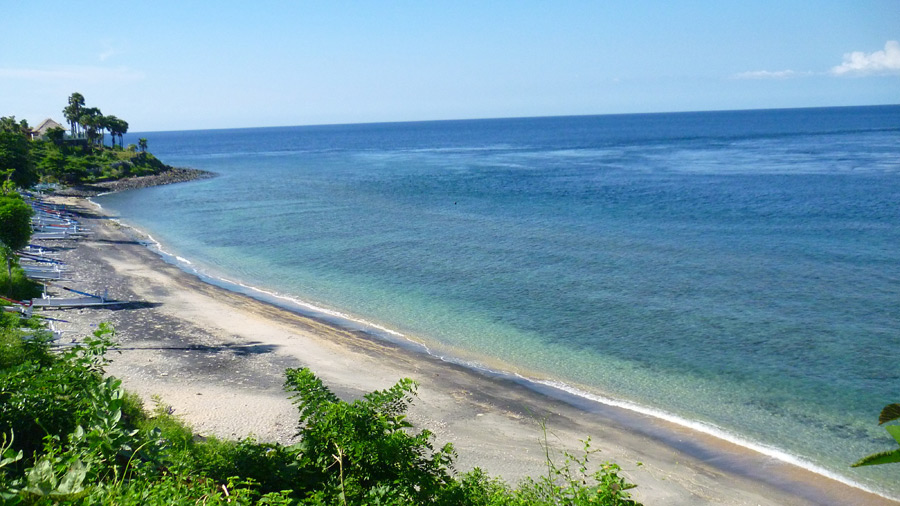Bali, Indonesia
February 26 – March 20

All of the sudden, it seemed perfectly fitting that we would end our seven month tour throughout Asia right where we were, in Bali. I tried not to tell myself that it was because we were exhausted. That after barreling through China, India, the Himalayas, Southeast Asia and part of the Indonesian archipelago, the somnolent beaches of the far eastern coast and the graceful greenery of the interior were successfully lulling us into a deep, enervated state that tended to affect most long-term travelers at some point in their journey. This fact was becoming all too apparent to Ryan and I, and when it came time to decide whether or not to renew our Indonesian visas for another thirty days, it seemed the decision had already been made for us. Sulawesi was just too many boat rides away…as was Kalimantan, Sumatra, and the rest of Nusa Tenggara. And never mind the fact that the entire island was redolent of the gorgeous frangipani that magically managed to bloom outside the windows of nearly every hotel and losmen.
But then, while in a salty beachside café near the off-shore wreck of the USAT Liberty, I saw my justification for it all. In the 18th century, a British naturalist (and a contemporary of Darwin) by the name of Sir Alfred Russell Wallace determined that there existed an (imaginary) zoological boundary that divided the eco-zones of Asia and Australia. The “Wallace Line” cut neatly down the Lombok Strait, thus demarcating Bali to the east (Asia) and Lombok to the west (Australia). Despite the relatively short distance between the two islands (35 kilometers), Wallace observed that the deep channel between the two formed a natural water barrier that existed even when sea levels were lower during the Ice Age, and prevented the local flora and fauna from commingling or cross-pollinating for more than 50 million years. Anyone who’s ever visited both islands can agree that Bali, with its million shades of green, and Lombok, with its dusty moonscapes, are horses of vastly different colors. This was reason enough to me. After all my fretting about our inadequacies as travelers, we unanimously agreed that Bali was it: the official boundary marking the end of Asia.
Despite it all, we quite capably filled 20 days on Bali with equal measures of adventure and time spent unconscious in a pool chair. After several days in the somewhat self-important artist’s enclave of Ubud, we fled the humidity for the higher ground of Gunung Batur, one of Bali’s three active volcanoes. Along the way, women wrapped in batik balancing towering offerings of rice, fruit and smoldering sticks of incense on their heads, outnumbered the passing motorbikes. Rice terraces in shades of electric green formed vast geometrical compositions that took our breath away as we sped past on our motorbike, and coconut palms caught the waning sunlight, which, with streaks of gold, fused the dark, lustrous green of their outer fronds with the silver-blue-gray of the stormy late afternoon sky. Near Penelokan, whose name means “beautiful view”, we savored fresh-from-the-tree passion fruits, rambutan, mangosteen, sakan (snake fruit), and sharply acidic tangerines at a small road-side stand with the specter of Batur just around the bend.
Arcing around the Northern Coast, we stopped along the black, volcanic sands of Lovina, and from the edge of our hotel’s infinity pool, we watched each evening as the sun slipped gracefully into the glassy stillness of the Savu Sea. One day, we ventured further afield by motorbike, in search of durian, lovingly nicknamed the “Ass Fruit” by many western travelers. We found a woman selling it by the outskirts of town, and for the equivalent of a dollar, we were soon sinking our teeth into the infamously putrid-smelling flesh. This was an experience I had been looking forward to ever since I arrived in South East Asia, and I was intrigued by descriptions I had read of the fruit, including British novelist Anthony Burgess, who likened the experience to “consuming vanilla custard while sitting on a latrine”. Sure enough, the durian was indeed creamy with a consistency roughly akin to a ripe avocado, and there was a subtle sweetness there as well. But for some reason (perhaps our durian was past its prime), the thing went down with an odd curry-like aftertaste that foreshadowed the horror to come.
Back on our bike, Ryan turned up a steep track that led up a ridge we guessed would make for a brilliant vista over the black coast. From where we were, the long, unbroken ridge rose darkly and resembled the crest of a wave before it broke and crumbled into the verdant wash of rice paddy that appeared to eddy before the hills all the way down to the coast. Small, thatched huts where villagers took respite from the sun during harvest became scraps of tidal spindrift amidst a sea of green. When the sun began to list at an angle to the earth, we decided to pluck our way gingerly back down the hillside, Ryan struggling to balance the bike around hairpin bends without turning us all out in the volcanic gravel that dusted the sides of the narrow road. A fellow from the hillside village caught up with us and gave us a characteristic Balinese grin.
“You from Australia, yes?”
The durian was performing elaborate flip-flops along my digestive track now, unsure of whether or not it would continue along its trajectory or instead reverse its direction entirely.
“U…U…U.S.A. We’re from the U.S.A.” I stammered.
From the back of his motorbike, the fellow introduced himself as Nyoman (in Bali, all people named Nyoman are the third child born in a family), and proceeded to tell us that he had an older brother working on a cruise ship in the United States. Had we heard of Carnival Cruise Lines? We learned that Nyoman himself lived with his parents in the village of Tigawasa (although he had ambitions to work in a hotel in Lovina), and was off to visit his other older brother in Amlapura where everyone was celebrating his niece’s birthday, who may or may not be Oliver’s age. My face was a picture of earnestness and terror as I endeavored to answer his question, and I couldn‘t help but wonder whether this fellow‘s curiosity was piqued enough for him to stick around assuming the three of us plummeted off the side of the road and into the ravine below.
Needless to say, Ryan managed to bring us down intact. The durian was coming up on me in baleful bursts of gas that surely had the power to rouse Lovina’s ancestral spirits, but we were alive, and ready to move on to our next destination along the coast, Amed.
Beautiful Amed is one of Bali’s sleepiest touristed coastal towns. When we arrived squarely in the middle of the off-season, we were able to secure a room in the swishest hotel in town which overlooked the sea, had satellite TV, air-conditioning, free breakfast and the softest beds we had enjoyed in months; all to the tune of a little more than $50 USD a night. In other words, for less than the price of the grimiest hostel in Australia, we took every opportunity to indulge our weary souls for the next several days, right down to the $10 USD Balinese massages we suffered through on the gazebo overlooking the beach at sunset.
Our time in Amed was our saltwater pearl; precious, hard to come by, and more beautiful than words can describe. From our outdoor shower set within a private garden, the intoxicating perfume of night jasmine drifted in on the salt air while the Southern Cross glimmered distantly from a swathe of stars above. Directly behind us, a volcanic mountainscape rose up violet at dusk and emerald during the day; at its southeastern horizon, Mount Agung tumbled sharply down to the sea and formed smooth black pebbled beaches that hissed like rain on a roof as they were carried back and forth by the tide. Near a WWII wreck, we swam headfirst into a juvenile barracuda and spiraled in a vortex of giant trevally as they schooled around the wreck of the USAT Liberty. We rode our motorbike every day up and down the tiny coastal road that plied the surrounding cliffs where below us, fishermen’s junkung (trimeran sailboats) lined the beaches that opened to spectacular coral terraces glittering in the late afternoon sunlight. By the limpid sea, Ollie tried to futilely to skip rocks with Ryan, and hurled enormous handfuls of hot, black pumice into the sea. Our son’s hair had again grown into the flaxen tendrils that I am so averse to cut away, and Ryan was brown and lean and sharp from the sun and a diet of rice and fresh fish. Here we simply escaped time; we became as much a part of our surroundings as the man who drove his ox in his fields, or as the small peeper frogs that called to one another from the little saltwater inlets that ran deep into the countryside.

Several days later, we rustled ourselves along to Sanur, a popular strand of beach in the South East nearing Kuta and the hordes of other travelers. Here we planned to sit tight through Nyepi, the “Day of Silence” that marks Bali’s Lunar New Year. For a period of twenty-four hours, every individual taking refuge on Bali’s shores was expected to observe strict rules in accordance with holiday, which included no working, no entertainment or pleasure, no traveling, and limited use of electricity.
The night before was a sort of Balinese Halloween, where villagers marched out their “ogoh-ogoh“, massive papier-mâché statues of demons engaged in various malicious activities. The sculptures are meant to represent the subversive and wicked tendencies of humankind, and it is the very essence of Nyepi that these effigies be burnt or otherwise destroyed at the stoke of midnight on the New Year. The parade of creatures made for fantastic theater, although Oliver might have disagreed. From his perch on top of Ryan’s shoulders, he could see the ogoh-ogoh advancing through the crowds, and his shrieks hit such an octave that they startled the German tour group all the way on the other side of the street.
The following day for more than seven hours, Ollie frolicked in the pool and scrambled like a monkey on fire all over the hotel compound, accompanied by his sweethearts, a ten-year-old Dutch girl named Yanu and two-year-old Aussie, Grace. When the lights started to flicker off at six, Yanu could barely keep her head up through dinner, and Grace had long since gone to bed. Ollie was, once again, the last man standing.
We whiled away our last three nights in Asia on Nusa Lembongan, a tiny island to the southeast. From the cliffs overlooking a rollicking, wave tossed, turquoise bay, it seemed suitable to end here on this corner of the earth where we could slip out of our walking shoes for a time and stare at the sea. There, beyond the strait that separated this land from another; one vastly different, forever a world away.


Hey new friend,
Finally I got to open your blog. I haven't read the whole story yet, but I'll read all your journey. Interesting! Anyway, Oliver stick in my mind and story of holiday. Especially at the part of how we got to know each other at swimming pool. I got a really good pic of you guys in there.
Maylan